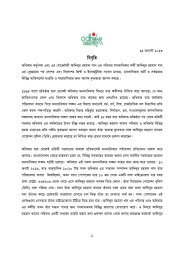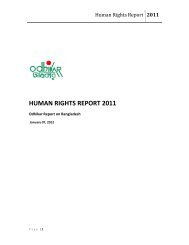Please - Odhikar
Please - Odhikar
Please - Odhikar
You also want an ePaper? Increase the reach of your titles
YUMPU automatically turns print PDFs into web optimized ePapers that Google loves.
National Police Journal one of the Inspector Generals of Police, Mr. Nair, wrote that there are<br />
15 to 20 thousand children who get lost every year. Hardly 15 to 20% of these children could be<br />
traced. Where do the untraced children end up? It is said most of these children are trafficked<br />
and sold to brothels.<br />
Society has looked down on these victimized girls and has hardly come to their rescue.<br />
Community leaders, religious leaders and even family members have not accepted these<br />
victimized girls and the abusers mostly go scot-free. There are Government and NGO run home<br />
for such girls as is provided in the National Plan of Action (1998) or under different Acts. India<br />
has signed CEDAW and The Rights of the Child Convention as well as SAARC "Convention on<br />
preventing and combating trafficking in women and children for prostitution" and is bound to<br />
follow these norm and standards through administrative and legislative measures.<br />
The National Plan of Action to Combat Trafficking and Commercial Sexual Exploitation 1998<br />
provides for shelter homes for rescued girls and women, restoration of such girls to their families<br />
and repatriation in case of cross border trafficking.<br />
In most cases the family does not want to take back the girl child on the plea that the other<br />
daughters in the family have to be given in marriage and as such they can't take back a sexually<br />
exploited or trafficked girl because the family will be socially boycotted. The fact remains that<br />
most of the victims remain unaccepted into the family and to the community. A lot of awareness<br />
raising at the community level needs to be done for attitudinal change towards such victim girl.<br />
Even a passing remark made to such victim might make her mentally deranged and might<br />
instigate and attempt to take revenge on society or even suicide.<br />
The system that prevails in the police and judiciary while dealing with such female victims need<br />
to be changed radically. It is found that such victims change their name and addresses with fear<br />
that her family would be informed and she will be accused/blamed. In several cases it has been<br />
found that they ultimately give actual names and addresses after counseling has been given for a<br />
few months. Once the FIR is made it is difficult to change the record and put in the actual name.<br />
It makes thing difficult for such a girl to be restored back to the family even if the family is<br />
agreeable to take her back. The process takes a long time before she is actually restored back to<br />
her family.<br />
Now let me narrate another incident to mention another type of victim. Last June, during the hot<br />
summer month, a person felt very thirsty in a village of South India and tried to drink water from<br />
a village well. After collecting water from the well, just as he was about to drink it, he was<br />
severely beaten and a number of charges were made against him. His only crime was that he<br />
belonged to a low caste and the well was meant for the use of those of higher castes. Here a<br />
person is victimized because of his low socio-economic status and caste.<br />
In India, one may find another category of victims who suffer often due to socio-political<br />
reasons. Whenever there is any communal tension and conflict, people suffer and become<br />
victims of circumstance. In the context of administration of justice, a witness plays a very<br />
crucial role in protecting the rights of the victims. One cannot overlook two important issues in<br />
the context of protecting and promoting the rights of the victims. One is the socio economic<br />
background of the victims and the other is the background of the offender. If the victim belongs<br />
to low socio economic status and the offender belongs to high socio economic status, it often<br />
Report 2005<br />
171











